Top Rankings
Powers SD 31 School District ranks among the top 20% of public school district in Oregon for:
Category
Attribute
Student Attention
Lowest student:teacher ratio (Top 1%)
For the 2025 school year, there is 1 public elementary school serving 63 students in Powers SD 31 School District. This district's average elementary testing ranking is 1/10, which is in the bottom 50% of public elementary schools in Oregon.
Public Elementary School in Powers SD 31 School District have an average math proficiency score of 15% (versus the Oregon public elementary school average of 32%), and reading proficiency score of 25% (versus the 44% statewide average).
Minority enrollment is 30% of the student body (majority American Indian), which is less than the Oregon public elementary school average of 41% (majority Hispanic).
Overview
This School District
This State (OR)
# Schools
2 Schools
1,027 Schools
# Students
117 Students
367,441 Students
# Teachers
14 Teachers
20,839 Teachers
Student : Teacher Ratio
8:1
8:1
District Rank
Powers SD 31 School District, which is ranked within the bottom 50% of all 186 school districts in Oregon (based off of combined math and reading proficiency testing data) for the 2021-2022 school year.
The school district's graduation rate of 50% has stayed relatively flat over five school years.
Overall District Rank
#171 out of 189 school districts
(Bottom 50%)
(Bottom 50%)
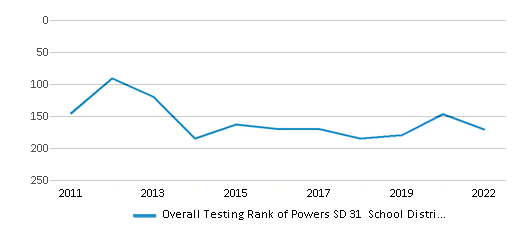
Math Test Scores (% Proficient)
15-19%
31%
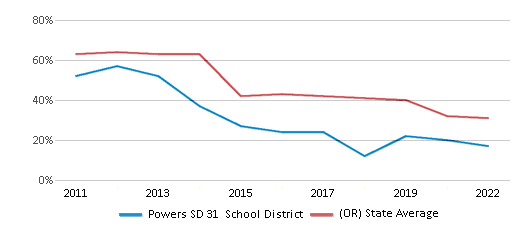
Reading/Language Arts Test Scores (% Proficient)
25-29%
44%

Science Test Scores (% Proficient)
≤20%
30%
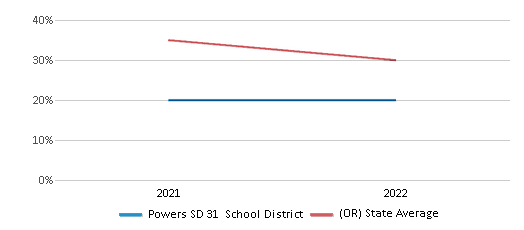
Graduation Rate
(20-21)≥50%
81%

Students by Ethnicity:
Diversity Score
0.47
0.59
# American Indian Students
10 Students
3,950 Students
% American Indian Students
9%
1%
# Asian Students
n/a
14,976 Students
% Asian Students
n/a
4%
# Hispanic Students
n/a
92,275 Students
% Hispanic Students
n/a
25%
# Black Students
n/a
8,831 Students
% Black Students
n/a
2%
# White Students
81 Students
215,165 Students
% White Students
69%
59%
# Hawaiian Students
n/a
3,290 Students
% Hawaiian Students
n/a
1%
# Two or more races Students
26 Students
27,772 Students
% of Two or more races Students
22%
8%
Students by Grade:
# Students in PK Grade:
-
-
# Students in K Grade:
10
35,045
# Students in 1st Grade:
6
38,201
# Students in 2nd Grade:
5
40,364
# Students in 3rd Grade:
13
39,761
# Students in 4th Grade:
10
41,356
# Students in 5th Grade:
9
41,259
# Students in 6th Grade:
10
41,436
# Students in 7th Grade:
7
36,830
# Students in 8th Grade:
10
37,438
# Students in 9th Grade:
12
3,418
# Students in 10th Grade:
9
3,820
# Students in 11th Grade:
9
4,067
# Students in 12th Grade:
7
4,446
# Ungraded Students:
-
-
District Revenue and Spending
The revenue/student of $22,444 is higher than the state median of $18,279. The school district revenue/student has grown by 6% over four school years.
The school district's spending/student of $20,410 is higher than the state median of $19,325. The school district spending/student has grown by 6% over four school years.
Total Revenue
$3 MM
$9,902 MM

Spending
$2 MM
$10,468 MM
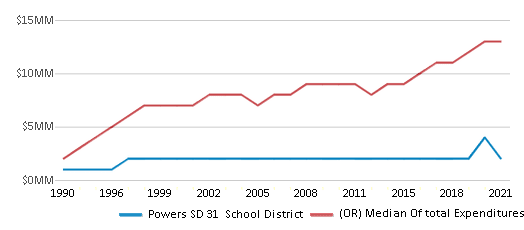
Revenue / Student
$22,444
$18,279
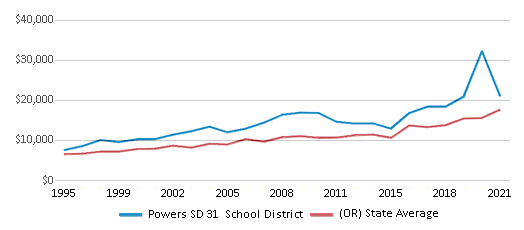
Spending / Student
$20,410
$19,325
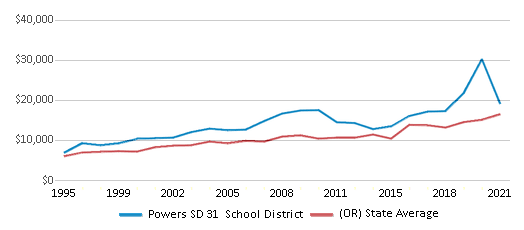
Best Powers SD 31 School District Public Elementary Schools (2025)
School
(Math and Reading Proficiency)
(Math and Reading Proficiency)
Location
Grades
Students
Rank: #11.
Powers Elementary School
(Math: 11-19% | Reading: 20-29%)
Rank:
Rank:
2/
Bottom 50%10
Poplar St
Powers, OR 97466
(541) 439-2281
Powers, OR 97466
(541) 439-2281
Grades: K-6
| 63 students
Recent Articles

Year-Round Or Traditional Schedule?
Which is more appropriate for your child? A year-round attendance schedule or traditional schedule? We look at the pros and cons.

Why You Should Encourage Your Child to Join a Sports Team
Participating in team sports has a great many benefits for children, there is no doubt. In this article you will learn what those benefits are.

White Students are Now the Minority in U.S. Public Schools
Increasing birth rates among immigrant families from Asia and Central and South America, combined with lower birth rates among white families, means that for the first time in history, public school students in the United States are majority-minority. This shift in demographics poses difficulties for schools as they work to accommodate children of varying language abilities and socio-economic backgrounds.





